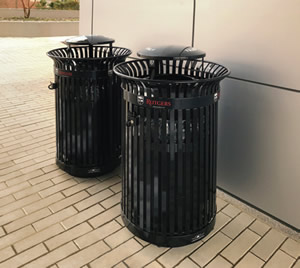Connected Waste Receptacles Enhance Efficiency

Victor Stanley’s connected waste receptacles made pickup and monitoring easier for campus staff, cutting down on unnecessary waste collection in the process.
Smart, connected phones, watches, thermostats, and even refrigerators (to name just a few examples) no longer occupy the fringe of technology. In fact, our culture’s epic shift toward “The Internet of Things,” as it’s known, is in full swing. Victor Stanley, a leading designer and manufacturer of premium site furnishings, has introduced a new generation of connected, intelligent waste receptacles. They’re smart enough, in fact, to save an estimated 40 percent on litter and recycling collection expenses each year.
Mr. Patrick Harrity, Rutgers University’s director of Grounds & Fleet Operations, adopted the new waste management system in an effort to initiate “less time spent on trash bin dumping labor and less trash bag usage.”
Traditional waste management allows for receptacles to overfill before they are collected—an aesthetic and olfactory nuisance, for sure—while others sit empty, yet are collected anyway. Victor Stanley’s innovative approach allocates collection resources where and when they are needed. It turns out these smart receptacles save not only time, but also decrease fuel costs and carbon footprints.
Using GPS in conjunction with other sensors, the receptacles continuously monitor and transmit fill levels, while also conveying temperatures, weights, and other environmental data to a custom online platform. Monitoring of containers provides a holistic view of an area’s trash and recycling status, and improves landfill diversion.
Campuses can employ networks of connected receptacles that enable collection planning and routing that is substantially more efficient. To maintain aesthetics and prevent vandalism, Victor Stanley’s sensors are hidden within their litter receptacles or recycling stations. Mr. Harrity is pleased with the seamless integration, noting that Relay “matches all our other receptacles.” Victor Stanley Relay is available for new receptacles and as a retrofit for their side-door receptacles.
victorstanley.com/product/relay
This article originally appeared in the College Planning & Management September 2018 issue of Spaces4Learning.